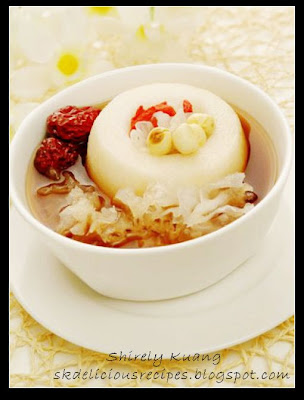Basic introduction
Chinese herbal cuisine is unique in China and has a long history. Based on traditional Chinese herbal medicine practice, it combines strictly processed traditional Chinese medicine with traditional culinary materials to produce delicious food with health restoring qualities. In China, people contend that food tonic is much better than medicine tonic in fortifying one's health. To cook medicinal food, one has a large variety of fine materials to choose from and each material has its own unique flavor. Generally, processed herbal materials
are more commonly used in order to avoid strong odors. However, individuals of different physical status need to select different herbs. The selection of herbs will depend on each individual's condition of health. Due to its herbal nature, it is better to take medicinal food according to the doctor's prescription.
are more commonly used in order to avoid strong odors. However, individuals of different physical status need to select different herbs. The selection of herbs will depend on each individual's condition of health. Due to its herbal nature, it is better to take medicinal food according to the doctor's prescription.
There is a wide choice of foods that are used in many different ways to promote health and well-being. It is estimated that there are more than 600 different kinds of resource ranging from cereals, fruits, vegetables, meats and marine products. Many of these will be unfamiliar to foreigners who may be reluctant to try them; however all are quite precious and effective in the field of medicinal food. Many different ingredients are used to add to the appeal as well as to strengthen effects of the cuisine. Wine, sugar, oil, salt, vinegar and honey, and other commonly available items such as almonds, mandarin orange, or peanuts, all are utilized in the cooking process.
Classification
According to its respective functions, medicinal cuisine is classified under four categories: prevention cuisine, health-protection cuisine, therapeutic cuisine and healing cuisine.
Prevention cuisine
Prevention cuisine builds resistance to potential ailments. Mung bean soup is considered helpful as a guard against heat stroke in summer. Lotus seeds, lily, yam, chestnuts, and pears can assist in the prevention of dryness in autumn and a strengthening of resistance to cold in winter.
Health-protection
Health-protection cuisine refers to reinforcement of required nutritional food correspondingly to maintain the organic health. A soup of pumpkin and almond can help lose weight; soup of angelica and carp can add beauty; and ginseng congee can give more strength.
Therapeutic cuisine
Therapeutic cuisine aims at the specific pathology. Fried potatoes with vinegar can adjust the organ and restrain hypertension and carp soup with Tuckahoe may enrich the strength of blood plasma albumen to help reduce swelling.
Healing cuisine
Healing cuisine is the medicinal food for rehabilitation after severe illness. Broiled sheep's heart with rose or braised mutton with angelica will help to rebuild a healthy constitution.
Have a try and you will enjoy the delicacy while benefiting a lot from the nourishment. It would be a really amazing experience!



No comments:
Post a Comment